The Vanishing Chinese Traditional Handicrafts
Many say the best way to get to know a folk culture is through discovering its traditional handicrafts – I have no doubt. However, the folk handicrafts in China now are facing a destiny of vanishing, after so many twists and turns, and the impact of modern technology. Before these thousand-year-old cultural heritages die off and disappear from Chinese history, we should definitely make an effort to treasure and preserve them and push the craftsmanship to evolve with time.
1. Steelyard (杆秤)
The steelyard is a weighing tool in ancient China. It is simple to make and consists of a weight, a scale plate, a beam and a scale rope, and weighs the goods with its different scales. It is the earliest practical product of the principle of lever in China. In the ancient times, there was not electronic scale, and steelyard was an essential appliance for daily deal.
After we have electronic scale in modern times, young people can only see steelyard in museums and some traditional markets in the remote villages, not to mention the artists who make steelyard.
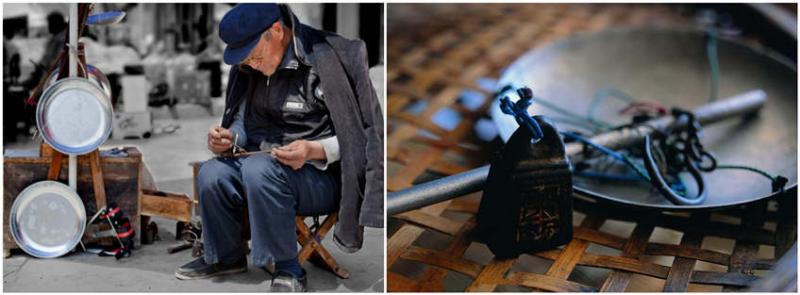
2. Dough figures (捏面人)
Dough figure was originated in the Han Dynasty. After successive generations of development and inheritance, the production process of dough figure is now simpler. Today the various home-made steamed buns are evolved from kneading dough. Dough figures are beautiful, delicate and edible, however, dough figure artisans are rare today and can only be seen in some tourist spots and traditional cultural streets.
Dough figure is also a traditional toy for children. Dough, wiper, bamboo stick, comb and scissors are essential tools for making dough figures. With a pair of light hands, a craftsman creates children a humble fairyland. Know more Chinese traditional toys for kids

3. Sugar figurines (糖画)
Sugar figurine is an industry in old Beijing, and one of the Chinese folk handicrafts. The peddlers walked through the hutong alleyways with their shoulder-carrying poles. At one end of the pole was a square cabinet with a frame. Under the cabinet there was a wooden cage with a semicircular opening held a small charcoal stove, on which a large spoon was filled with sugar (which was melted maltose).
This technology of sugar figurine requires the artist not only to have a full understanding of sugar products, but also to have certain artistic and creative ability.
Kids’ favorite snack, sugar figurine is a magic handicraft art. Maltose is fully melted and made into lifelike cute animals, such as rabbit, dragon, monkey…
Today you may see figurine requires stalls and the figurine requires artisans at Beijing Temple Fair during the Spring Festival (Chinese Lunar New Year) celebration.
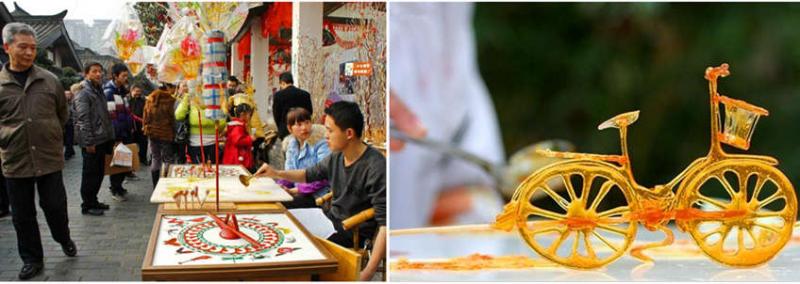
4. Chinese popcorn (爆米花)
The Chinese old-fashioned popcorn machine is an ancient popcorn machine. The "bang" of the popcorn is an interesting childhood memory of many post-70 and post-80 Chinese people. The mobile vendor walked through the streets and brought kids pure white popcorn.
The old-fashioned stove, the gourd shaped pressure cooker and the sack are now disappearing…
This old Chinese popcorn machine was featured on Discovery Channel's Myth Busters, and the video has since gone viral on Weibo. Many netizens said that they finally knew how raw corn turned into popcorn. But it's hard to see such a scene today.
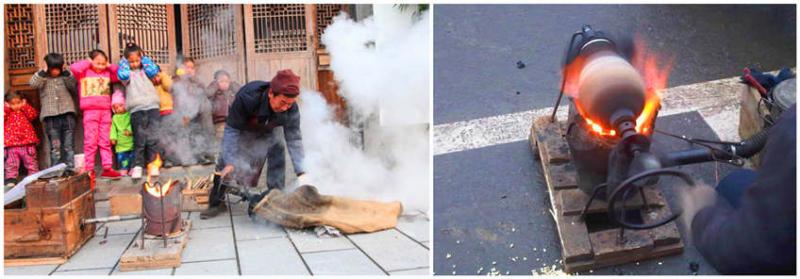
5. Wheat straw knitting craft (麦秸编织工艺)
Wheat straw weaving is a traditional handicraft with a history of more than two thousand years in China. Wheat straw handicrafts use wheat straw as raw material. The making processes include material selection, dyeing, mounting, design and lots of delicate handwork. After cutting, pasting, ironing and other processes, the lifelike animals, flowers and birds, pavilions, sunhat, straw fan, woven handbag, dustpan and other agricultural utensils and artistic crafts are made, with bright color, different variety, sizes and specification.
Wheat straw weaving handicraft embodies the outstanding artistic creativity of Chinese craftsman.
However, because of the time consuming, there are very few artists who can weave wheat straw now, and they can only be seen in some mountainous areas or ethnic minority areas, like Yunnan or Guizhou.
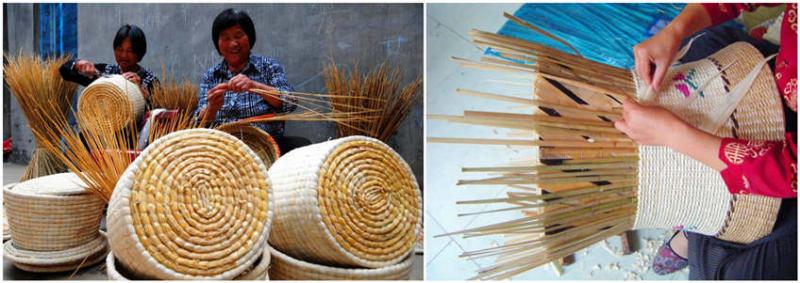
6. Handmade Chinese cloth shoes (纳鞋匠)
Handmade cloth shoes are a traditional soles manufacturing technology of ancient China. Because the sole of the shoe is mounted with white cloth, and is made of multiple layers, it gets its name -- the thousand-layer sole which is a typical feature of the handmade Chinese cloth shoes.
First of all, the shoe maker cuts out the pattern, then he/she uses the needle to weave through the sole and the upper with a thick rope fixing them together. Finally, tap the shoe with a hammer to build a perfect modeling.
The finished product is comfortable to wear, light and non-slip, warm in winter and breathable in summer.
With the development and change of society, the old skills of have handmade cloth shoes are vanishing today. Handmade cloth shoes can occasionally be seen. there are some old ladies making tiger-head shoes for children.

7. Brick carving (砖雕工艺)
Brick carving is an old, complicated handicraft art in China. Drill, plane and saw make the craftsman a real master, and help them create numerous tile masterpieces, showcased in the sophisticated architectural ornaments.
Brick carving technology evolved from the East Zhou Dynasty tile carving and Han Dynasty brick painting. Carving landscape, flowers, figures and other patterns on black bricks is a very important art form in ancient architectural sculpture. Brick carving used to decorate the temple, pagoda, nunnery and residential components and walls.
There are Shanxi brick carving, Huizhou brick carving, Guangdong brick carving and Linxia brick carving, with different distinguished features, but now there are fewer and fewer artisans are working on the carvings.
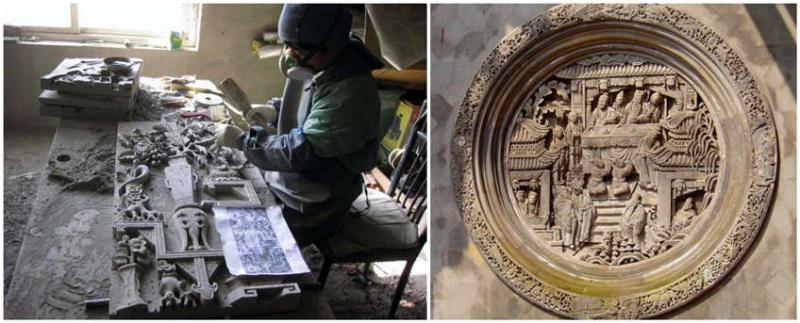
8. Silversmith (老银匠)
Silver has been part of Chinese ornamental folk culture for more than 4,000 years since the Warring States Period (770-256 BC). Chinese silversmith used special technique of controlling the fire to make silverware.
Melting, compacting, making tires, chiseling, welding, wire drawing, grinding, blowing with mouth to control the temperture of the fire... -- a handmade piece of beautiful silver ornament often needs more than a dozen or even more than 20 steps, and each step still needs several small steps to complete. With the rise of modern jewelry processing industry, few people know the traditional craftsmanship of making silverware by hand. Moreover, it takes a long time to make silverware by hand and has low profit, so fewer and fewer craftsmen hand-make silverware.
Today in some old towns and villages, like Lijiang Old Town and Pingyao Old Town, you may still find traditional silversmith shops, and see the craftsmen making silver ornaments on site.
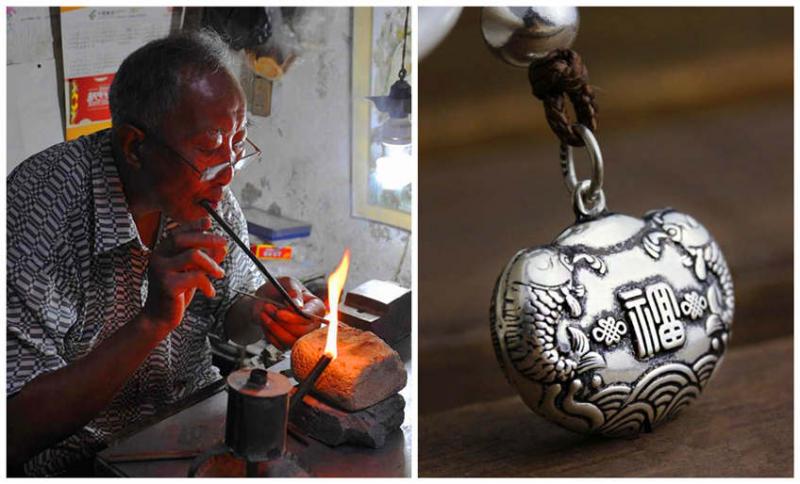
9. Chinese landscape painting mounting (国画装裱)
Landscape painting is one of the three quintessence of Chinese culture, and can only fully display its charm when mounted elaborately and elegantly.
Because of the colloid effect of the ink, calligraphy and painting created on rice paper and silk are always wrinkled and uneven, easy to break, and inconvenient to watch, spread and collect. Only after being mounted, and match the calligraphy/painting with the corresponding satin and brocade paper and silk, to enhance the vigor of the writing style and the intensity of color, the artistry of the works have a rise in quality.
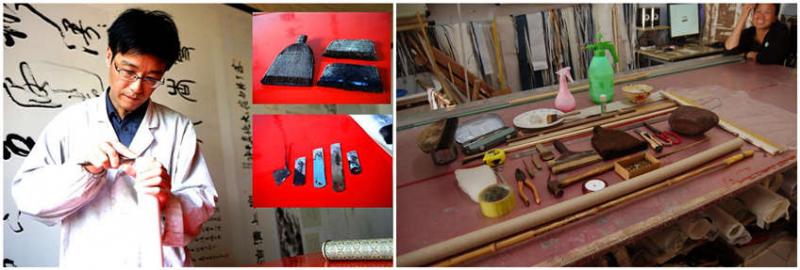
10. Wood carving (木雕)
Wood carving, a kind of sculpture, is often referred as a folk craft in China. Wood carving can be divided into three categories: three-dimensional round carving, root carving and relief carving.
The art of wood carving originated in the Neolithic Age. Wood carving fish appeared in the Hemudu Culture of Yuyao, Zhejiang more than 7,000 years ago. The woodcarving technology of Qin and Han Dynasties became mature, and the painting and carving techniques were exquisite and perfect. A great wood carving artisan must master the perfect sculpture skills, and is able to turn a plain wood into a masterpiece of artistic, aesthetic value.
However, in nowadays fewer and fewer young generations show interest in wood carving, and shoddy handmade wood carvings dominate the market. The traditional Chinese wooden carving skill is vanishing…
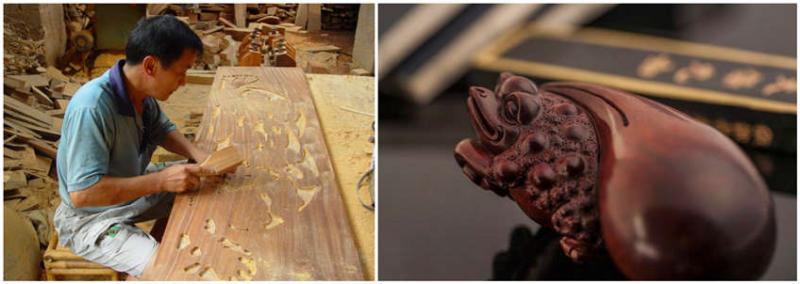
11. Paper-cut (剪纸)
Chinese paper cutting is a kind of folk art that uses scissors or carving knives to cut patterns on paper, which is used to decorate life or coordinate with other folk activities. Paper cutting craftsman usually combine a variety of images together, and simply show good wishes of life.
"Magpie climbing plum trees", “prosperity brought by the dragon and the phoenix”, “two mandarin ducks were tumbling merrily about in the water”, “carp jumps over the dragen gate”, and "the lion rolls hydrangea” are some popular themes for paper cutting.
Generally, ladies are better at paper-cuts. With their clever hands and a pair of scissors, beautiful flowers and lovely animals are born.
Some artisans in Beijing and other places of China are still practicing the art of paper cutting, and if you’re planning a China tour with kids, or a China educational tour for school students, you may consider adding a paper cutting class at Beijing hutong.
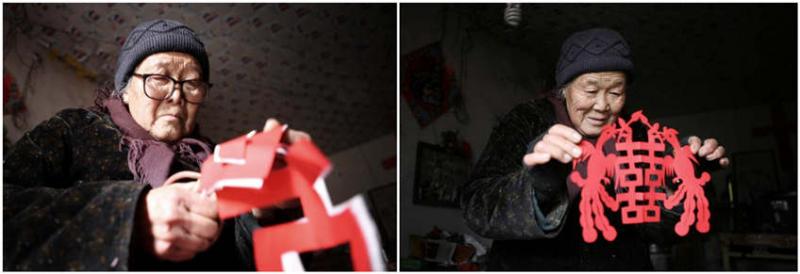
12. Chinese chop/seal (印章)
It is used as stationery printed on documents to indicate identification or signature. Generally, the seal will be dipped in pigment before printing. Those that do not dip in pigment but appear concave and convex after printing on the flat surface are called steel seals. Chinese chops are usually made of metal, wood, stone, jade and so on.
In China you may find some antique seals at antique markets, e.g. Panjiayuan Antique Market in Beijing. Or you can make yourself a unique and personalized Chinese handmade seal. The basic tools include stone, brush, grinding papers, Chinese art paper, engraving knife, etc.
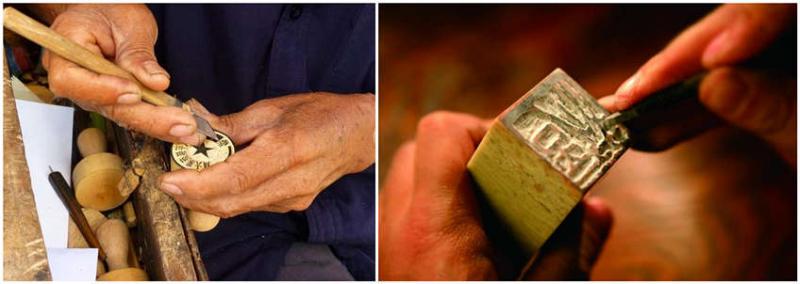
Do you know any vanishing Chinese folk art or traditional handcraft? Leave us a comment to let other people know.